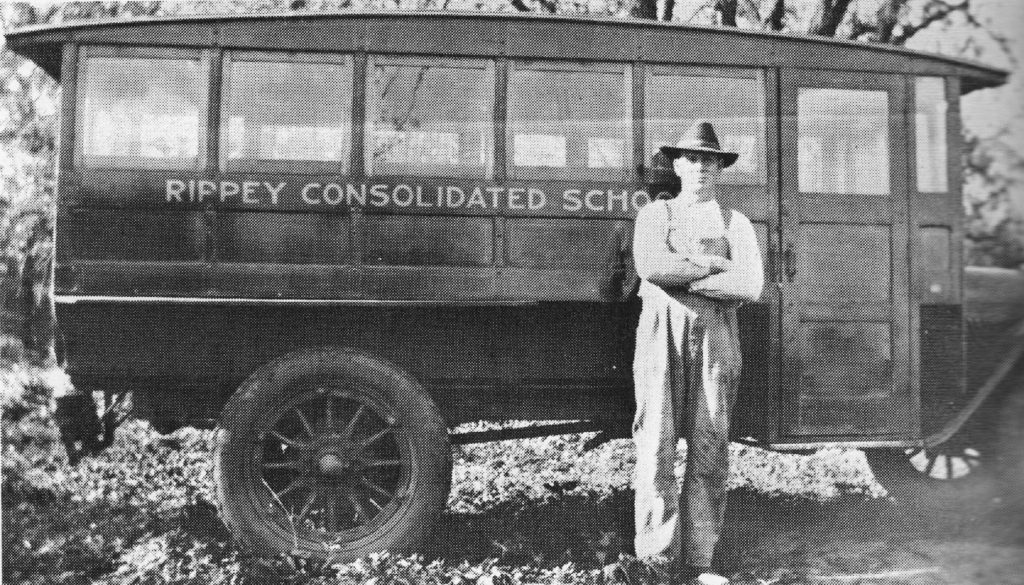What Do You Remember About Rippey?
The Rippey, Iowa, Sesquicentennial will be held on Saturday, August 1, 2020. If you have personal remembrances of Rippey, you are invited and encouraged to share those memorable stories. Just send your remembrance via email and we’ll get it posted on the Rippey News Web site, as well as on Facebook sites of the Friends of Rippey and the Rippey Sesquicentennial. You write down the anecdote or story–a page or two–and we’ll do the rest. Phyllis McElheney Lepke is serving as our volunteer coordinator and stories may be sent to her at Rippey150@gmail.com.
TRANSPORTATION VIA SCHOOL BUSES
Submitted by Mary Dorris Weaver interviewing Diane Hoskinson Ostrander
The Rippey Consolidated School was opened in 1921. There were 286 pupils. There were 6 bus routes: northwest, southwest, south central, northeast, west central, and southeast. The first country children were to be picked up promptly at 7:30. Bus rules included, “Each bus driver is instructed to stop his bus and see that it is properly flagged across all railroad tracks. He is also ordered to drive at a safe speed and at no time to exceed 20 miles per hour. Every precaution will be taken to guard the welfare of the children, both physically and morally”.
The school bus drivers for the Rippey Consolidated School prior to forming a merger with East Greene in 1962 apparently are all deceased.
An interview with Diane Hoskinson Ostrander, who drove a school bus for East Greene in the Rippey Community from 1974-1989, for 15 years, reveals a lot about rural transportation of school children in the 1970’s. Diane’s route began in Grand Junction, where she drove to the bus barn. She picked up her first student passengers (for a total of 50) at 7:15, with the route being about 35 miles. The route ran in the eastern and southern portion of the rural Rippey community. She dropped off the Rippey area students at the Rippey Center, and then drove to Grand Junction to provide transportation for the elementary students from the northern part of the district back to the Rippey Center. The process was reversed in the afternoon, with the last student getting off the bus at 4:30 P.M. At that time East Greene ran 5 bus routes, and when she began driving they were all driven by women, with the exception of the supervisor.
She drove the activity buses for the high school including football, music, and basketball. She was recruited to become a driver by Mr. Bob Cummings, then transportation director for East Greene. She studied for her chauffeur’s license, took the written test, and then had a required driving test. She passed the first time and became an East Greene driver in 1974.
She prides herself on only being stuck in the snow once, and credits that record with always proceeding with caution, driving slowly, and keeping her mantra the same as the one in 1921: the safety of the children.
The largest bus she drove had a capacity of 66, but she drove smaller buses, too, especially with the mid-day transportation of the kindergarten classes at East Greene. She shares a story that during his ride home, one kindergarten boy expressed that he was going to marry her when he grew up.
When she first began driving there were no cell phones nor C.B. radios in the buses. She always told the children departing the bus during a snow storm, that if a snow accident should happen to the bus, their parents could help by identifying the approximate location when calling for aid.
Diane always talked to her riders during adverse weather, reminding them she needed to focus on her driving and not be looking in her mirror regarding bus mischief. Throughout the interview she praised her student riders for being such good passengers.
She had one kindergarten student who really disliked school and was frequently ill just as he was arriving. She carried an ice cream bucket for vomiting incidences for him, and frequently gave him a little pep talk about facing the day. His mother told her at his high school graduation celebration, he never would have attended school had it not been for Diane.
She notes the decision to cancel school was made in the early morning hours by the superintendent and the transportation supervisor. Every winter she purchased a box of large garbage bags that she retained in the bus, thinking that she and students could wear them for insulation and warmth should an accident occur, and they became stranded.
She said she occasionally purchased treats for her students as a thank you for their being such good passengers.
A 1966 East Greene graduate, Diane fondly recalls driving the bus, “It was one of the best times of my life; people were always so nice to me.”

